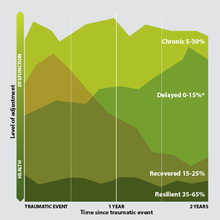When our faith in the world is threatened, or when our sense of security, normalcy, and integrity is damaged, the experience can be traumatic. It can lead to chronic stress with detrimental health consequences.
A traumatic event may be personally experienced or witnessed, imagined or experienced through empathy, and it may be caused by a variety of stressors of varying magnitude, frequency and duration.
Individual appraisal of such event can lead to different levels of impact, but three aspects are central to a traumatic experience: shock, wound, and lasting effects.
Among the many disturbing effects of post traumatic stress are emotional numbing, reexperiencing, survivor guilt, feeling of responsibility, anger, and heightened levels of arousal. The effects of trauma on both individuals and communities can be deep and long lasting.
In today’s world dominated by news of conflict, violence, brutality, bullying and natural disasters affecting millions of people around the globe, there is a need for effective strategies to cope with traumatic stress.
How to cope?
When our bodies are nurtured and fulfilled, challenged and exercised, we become physically fit. Similarly, when the mental, emotional, creative and spiritual self is nurtured and fulfilled, challenged and expressed, we are enriched and become mentally, emotionally and spiritually fit.
In a situation that calls for it, a physically fit person can probably handle bodily demands better than a physically unfit individual. Likewise, a person whose life is enriched, who is mentally, emotionally and spiritually fit, has more inner resources to face and recover from the annoyance of everyday stress, or from the physiological and psychological turmoil of a traumatic experience.
The realm of the inner self is always a subjective landscape. Physiological and psychological indicators associated with stressful experiences are sometimes difficult to measure and interpret. It is also unrealistic to expect that these indicators would be enough to tell the complete, complex, and multidimensional story of any personal experience.
However, in the past decades, the mind-heart-body interactions and interconnectedness have been investigated scientifically. Even post traumatic stress susceptibility can now be measured with specific biomarkers, and perhaps predicted. Gut bacteria flora (microbiome) imbalance has been linked with impaired stress responses and PTSD. Scientists also found that electrical stimulation of the vagus nerves may have the potential to reduce some PTSD symptoms.
Medical and scientific researchers have reported many findings on the health effects of and the physiological changes associated with stress and PTSD, and the health benefits of relaxation, emotional and spiritual fitness.
Besides exercising regularly and following a nutritious diet to maintain general health, there are other things that we can do in everyday life to enrich us, to reduce stress, or to combat at least some of the effects of a traumatic experience.
Music and art therapies have proven to be effective. Connecting with nature has immense healing power. Sharing with people who have gone through similar experiences helps put things in a more positive perspective. Relaxation therapies such as massage and meditation benefit both the body and the mind….
Calmness, beauty, understanding and faith brighten us up with hope. And when we are strengthened and filled with hope, we are more able to recover from trauma, or even turn a break into a breakthrough, a negative experience into a propelling force for growth.
A break?
American pediatrician Rachel Naomi Remen relates in her book chapter entitled “The Container” a healing story of an angry young boy, who had lost a leg to osteosarcoma.
Remen gave the boy a drawing pad and asked him to draw a picture of his body. He drew a sketchy outline of a vase with a heavy dark crack in the middle.
After two years of therapies, he showed Remen the same picture. The boy had added lines of yellow radiating from the crack in the vase all the way to the edge of the paper. Then he touched the crack and said quietly, “This is where the light comes through.”
“Suffering is intimately connected to wholeness.” Remen observed. And the wholeness of this break is the transformation of human suffering and a traumatic experience into a triumph of hope.





